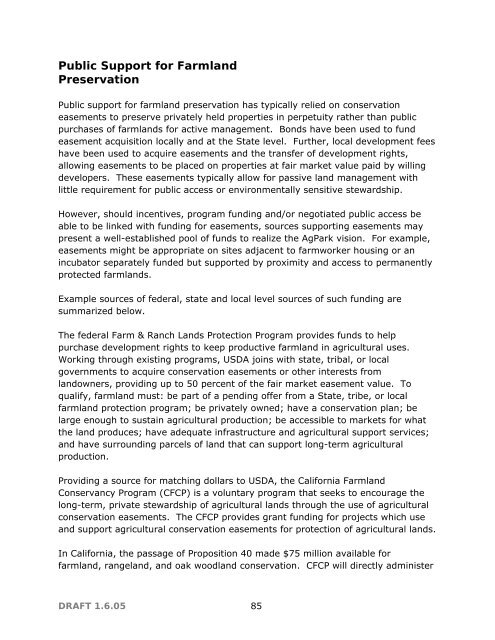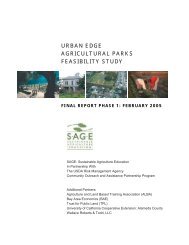A Feasibility Study for Urban Edge Agricultural Parks - SAGE
A Feasibility Study for Urban Edge Agricultural Parks - SAGE
A Feasibility Study for Urban Edge Agricultural Parks - SAGE
Create successful ePaper yourself
Turn your PDF publications into a flip-book with our unique Google optimized e-Paper software.
Public Support <strong>for</strong> FarmlandPreservationPublic support <strong>for</strong> farmland preservation has typically relied on conservationeasements to preserve privately held properties in perpetuity rather than publicpurchases of farmlands <strong>for</strong> active management. Bonds have been used to fundeasement acquisition locally and at the State level. Further, local development feeshave been used to acquire easements and the transfer of development rights,allowing easements to be placed on properties at fair market value paid by willingdevelopers. These easements typically allow <strong>for</strong> passive land management withlittle requirement <strong>for</strong> public access or environmentally sensitive stewardship.However, should incentives, program funding and/or negotiated public access beable to be linked with funding <strong>for</strong> easements, sources supporting easements maypresent a well-established pool of funds to realize the AgPark vision. For example,easements might be appropriate on sites adjacent to farmworker housing or anincubator separately funded but supported by proximity and access to permanentlyprotected farmlands.Example sources of federal, state and local level sources of such funding aresummarized below.The federal Farm & Ranch Lands Protection Program provides funds to helppurchase development rights to keep productive farmland in agricultural uses.Working through existing programs, USDA joins with state, tribal, or localgovernments to acquire conservation easements or other interests fromlandowners, providing up to 50 percent of the fair market easement value. Toqualify, farmland must: be part of a pending offer from a State, tribe, or localfarmland protection program; be privately owned; have a conservation plan; belarge enough to sustain agricultural production; be accessible to markets <strong>for</strong> whatthe land produces; have adequate infrastructure and agricultural support services;and have surrounding parcels of land that can support long-term agriculturalproduction.Providing a source <strong>for</strong> matching dollars to USDA, the Cali<strong>for</strong>nia FarmlandConservancy Program (CFCP) is a voluntary program that seeks to encourage thelong-term, private stewardship of agricultural lands through the use of agriculturalconservation easements. The CFCP provides grant funding <strong>for</strong> projects which useand support agricultural conservation easements <strong>for</strong> protection of agricultural lands.In Cali<strong>for</strong>nia, the passage of Proposition 40 made $75 million available <strong>for</strong>farmland, rangeland, and oak woodland conservation. CFCP will directly administerDRAFT 1.6.05 85





